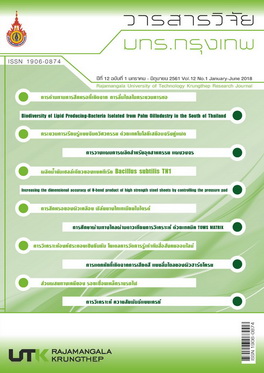พฤติกรรมการสึกหรอของผิวเคลือบฟิล์มบางไทเทเนียมไนไตรด์
บทคัดย่อ
การวิจัยนี้มีวัตถุประสงค์เพื่อศึกษาพฤติกรรมการสึกหรอของผิวเคลือบฟิล์มบางไทเทเนียมไนไตรด์ (TiN) ภายใต้การทดสอบการสึกหรอในสภาวะแบบแห้งตามมาตรฐาน ASTM G133-05 ในลักษณะการเคลื่อนที่ แบบไป-กลับและรูปแบบผิวสัมผัสระหว่างกันเป็นแบบ flat-on-flat โดยใช้แท่งกดทรงกระบอกขนาดเส้นผ่านศูนย์กลาง 10 มิลลิเมตร ซึ่งติดกระดาษทรายซิลิกอนคาร์ไบด์ที่มีขนาดความหยาบ 1000 กริท ไว้ที่ปลายแท่งกด ใช้ความเร็วรอบในการทดสอบ 200 และ 300 รอบต่อนาที และใช้น้ำหนักกด 5 และ 10 นิวตัน ทำการออกแบบการทดลองแบบส่วนประสมกลางและการวิเคราะห์พื้นผิวผลตอบสนองเพื่อหาสภาวะที่เหมาะสมที่สุด ผลการวิจัยแสดงให้เห็นว่าปัจจัยหลักทั้งสองปัจจัยคือความเร็วรอบและน้ำหนักกดมีอิทธิพลต่อค่าผลตอบสนองน้ำหนักที่หายไป และปัจจัยร่วมระหว่างสองปัจจัยมีผลกระทบต่อน้ำหนักที่หายไปอย่างมีนัยสำคัญที่ระดับนัยสำคัญ .05 ส่วนการวิเคราะห์พื้นผิวผลตอบสนองด้วยฟังก์ชันความพึงพอใจทำให้ได้สภาวะที่เหมาะสมคือความเร็วรอบ 282.07 รอบต่อนาที น้ำหนักกด 8.32 นิวตัน และน้ำหนักที่หายไป 0.0144 กรัม ในส่วนการวิเคราะห์โครงสร้างจุลภาคพบว่าพฤติกรรมการสึกหรอของชิ้นงานผิวเคลือบไทเทเนียมไนไตรด์มีลักษณะกลไกการสึกหรอแบบยึดติด
เอกสารอ้างอิง
[2] Costa MYP, Cioffi MOH, Voorwald HJC, et al. An Investigation on sliding wear behavior of PVD coatings. Tribol Int 2010; 43: 2196-202.
[3] Vettivel SC, Jegan R, Vignesh J, et al. Surface characteristics and wear depth profile of the TiN, TiAlN and AlCrN coated stainless steel in dry sliding wear condition. Surf Interf 2017; 6: 1-10.
[4] Rabinowicz E. Friction and wear of materials. 2nd ed. New York: John Wiley & Sons; 1995.
[5] Kennedy DM, Hashmi MSJ. Methods of wear testing for advanced surface coatings and bulk materials. J Mater Process Tech 1998; 77: 246-53.
[6] Myer RH, Montgomery DC. Response surface methodology: Process and product optimization using Designed Experiments. 2nd ed. New York: John Wiley & Sons; 2002.
[7] ชาญณรงค์ สายแก้ว. สถิติและการออกแบบการทดลองเชิงวิศวกรรม. ขอนแก่น: หน่วยสารบรรณ งานบริหารและธุรการ คณะวิศวกรรมศาสตร์ มหาวิทยาลัยขอนแก่น; 2557.
[8] Saikaew C, Wisitsoraat A, Sootticoon R. Optimization of carbon doped molyb- denum oxide thin film coating process using designed experiments. Surf Coat Tech 2010; 204: 1493-502.
[9] El-Tayeb NSM, Yap TC, Venkatesh VC, et al. Modeling of cryogenic frictional behavior of titanium alloys using response surface methodology approach. Mater Des 2009; 30: 4023-34.
[10] Saravanan I, Perumal AE, Vettivel SC, et al. Optimizing wear behavior of TiN coated SS 316L against Ti alloy using Response Surface Methodology. Mater Des 2015; 67: 469-82.
[11] Suresh S, Moorthi NSV, Vettivel SC, et al. Mechanical behavior and wear prediction of stir cast Al-TiB2 composites using response surface methodology. Mater Des 2014; 59: 383-96.
[12] Bonny K, De Baets P, Perez Y, et al. Friction and wear characteristics of WC-Co cemented carbides in dry reciprocating sliding contact. Wear 2010; 268: 1504-17.
[13] Rajeev VR, Dwivedi DK, Jain SC. Effect of load and reciprocating velocity on the transition from mild to severe wear behavior of Al-Si-SiCp compo- sites in reciprocating conditions. Mater Des 2010; 31: 4951-59.
[14] Yu L, Bahadur S. An investigation of the transfer film characteristics and the tribological behaviors of poly- phenylene sulfide composites in sliding against tool steel. Wear 1998; 214: 245-51.
[15] Srisattayakul P, Saikaew C, Wisitsoraat A, et al. Reciprocating two-body abrasive wear behavior of DC magnetron sputtered Mo-based coatings on hard- chrome plated AISI 316 stainless steel. Wear 2017; 378-79: 96-105.
ดาวน์โหลด
เผยแพร่แล้ว
รูปแบบการอ้างอิง
ฉบับ
ประเภทบทความ
สัญญาอนุญาต
กองบรรณาธิการวารสารวิชาการ มหาวิทยาลัยเทคโนโลยีราชมงคลกรุงเทพ มีความยินดีที่จะรับบทความจากอาจารย์ นักวิจัย นักวิชาการทั้งภายในและภายนอกมหาวิทยาลัย ในสาขาวิชาวิทยาศาสตร์และเทคโนโลยี ได้แก่ สาขาวิชาวิทยาศาสตร์ วิศวกรรมศาสตร์ และสาขาอื่นๆ ที่เกี่ยวข้อง รวมถึงสาขาต่างๆ ที่มีการบูรณาการข้ามศาสตร์ที่เกี่ยวข้องวิทยาศาสตร์และเทคโนโลยี ที่เขียนเป็นภาษาไทยหรือภาษาอังกฤษ ซึ่งผลงานวิชาการที่ส่งมาขอตีพิมพ์ต้องไม่เคยเผยแพร่ในสิ่งพิมพ์อื่นใดมาก่อน และต้องไม่อยู่ในระหว่างการพิจารณาของวารสารอื่น
การละเมิดลิขสิทธิ์ถือเป็นความรับผิดชอบของผู้ส่งบทความโดยตรง บทความที่ได้รับการตีพิมพ์ต้องผ่านการพิจารณากลั่นกรองคุณภาพจากผู้ทรงคุณวุฒิและได้รับความเห็นชอบจากกองบรรณาธิการ
ข้อความที่ปรากฏอยู่ในแต่ละบทความที่ตีพิมพ์ในวารสารวิชาการเล่มนี้ เป็นความคิดเห็นส่วนตัวของผู้เขียนแต่ละท่าน ไม่เกี่ยวข้องกับมหาวิทยาลัยเทคโนโลยีราชมงคลกรุงเทพแต่อย่างใด ความรับผิดชอบด้านเนื้อหาและการตรวจร่างบทความแต่ละบทความเป็นของผู้เขียนแต่ละท่าน หากมีความผิดพลาดใดๆ ผู้เขียนแต่ละท่านจะต้องรับผิดชอบบทความของตนเองแต่ผู้เดียว
กองบรรณาธิการขอสงวนสิทธิ์มิให้นำเนื้อหา หรือข้อคิดเห็นใดๆ ของบทความในวารสารวิชาการ มหาวิทยาลัยเทคโนโลยีราชมงคลกรุงเทพ ไปเผยแพร่ก่อนได้รับอนุญาตจากกองบรรณาธิการ อย่างเป็นลายลักษณ์อักษร ผลงานที่ได้รับการตีพิมพ์ถือเป็นลิขสิทธิ์ของวารสาร






